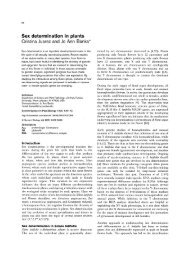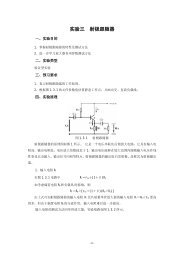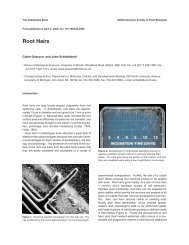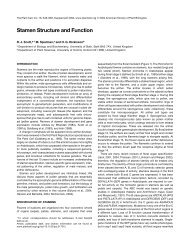Pollen and Stigma Structure and Function: The Role of Diversity in ...
Pollen and Stigma Structure and Function: The Role of Diversity in ...
Pollen and Stigma Structure and Function: The Role of Diversity in ...
You also want an ePaper? Increase the reach of your titles
YUMPU automatically turns print PDFs into web optimized ePapers that Google loves.
<strong>Pollen</strong> <strong>and</strong> <strong>Stigma</strong> <strong>Structure</strong> <strong>and</strong> <strong>Function</strong><br />
S93<br />
(Mayfield <strong>and</strong> Preuss, 2000; Mayfield et al., 2001). <strong>Pollen</strong> coats<br />
also conta<strong>in</strong> volatile lipids for poll<strong>in</strong>ator attraction, such as<br />
polyunsaturated C18 free fatty acids, which are known to be potent<br />
honeybee attractants (Hopk<strong>in</strong>s et al., 1969). Chemical analyses<br />
<strong>of</strong> 15 plant species from 10 families revealed that the pollen<br />
<strong>of</strong> each species emits its own characteristic mixture <strong>of</strong> volatiles,<br />
with the three major classes <strong>of</strong> volatiles seen <strong>in</strong> floral scents,<br />
isoprenoids, fatty acids, <strong>and</strong> benzoids, present <strong>in</strong> pollen volatiles<br />
to different degrees depend<strong>in</strong>g on the species (Dobson <strong>and</strong><br />
Bergstrom, 2000). Although the set <strong>of</strong> known pollen coat prote<strong>in</strong>s<br />
<strong>in</strong> Arabidopsis <strong>and</strong> Brassica is substantial, it represents only<br />
a small subset <strong>of</strong> the prote<strong>in</strong>s from the tapetal cytoplasm.<br />
Extensive degradation <strong>of</strong> the released tapetum materials likely<br />
occurs before dehiscence, with the surviv<strong>in</strong>g coat components<br />
assembl<strong>in</strong>g <strong>in</strong>to structures that are resistant. Support for this<br />
idea is provided by Arabidopsis mutants lack<strong>in</strong>g long-cha<strong>in</strong><br />
pollen coat lipids; <strong>in</strong> these cases, prote<strong>in</strong>s are deposited on the<br />
pollen surface but disappear from the coat<strong>in</strong>g before the pollen is<br />
released (Preuss et al., 1993).<br />
<strong>Stigma</strong> <strong>Diversity</strong> <strong>and</strong> Development<br />
A survey <strong>of</strong> 1000 species has shown that stigma structure<br />
generally correlates with taxonomic subdivision <strong>and</strong> argues for<br />
the coevolution <strong>of</strong> pollen <strong>and</strong> stigma structures. For example,<br />
angiosperm species that produce tr<strong>in</strong>ucleate pollen typically<br />
have dry stigmas, whereas b<strong>in</strong>ucleate pollens <strong>of</strong>ten <strong>in</strong>teract with<br />
wet stigmas (Heslop-Harrison, 1977). As diverse as they may be,<br />
all stigmas perform the same functions. <strong>Stigma</strong>s capture pollen,<br />
support hydration <strong>and</strong> germ<strong>in</strong>ation, <strong>and</strong> <strong>of</strong>fer entry po<strong>in</strong>ts <strong>and</strong><br />
guidance to pollen tubes en route to the ovaries. <strong>Stigma</strong>s do not<br />
only discrim<strong>in</strong>ate between different pollen gra<strong>in</strong>s; they also<br />
promote outcross<strong>in</strong>g or self-fertilization by the coord<strong>in</strong>ated<br />
tim<strong>in</strong>g <strong>of</strong> their maturation with pollen release. This phenomenon,<br />
termed dichogamy, has been <strong>in</strong>vestigated for >200 years. Two<br />
forms <strong>of</strong> dichogamy have been recognized: prot<strong>and</strong>ry <strong>and</strong><br />
protogyny, <strong>in</strong> which the male or female structures, respectively,<br />
are the first to mature (Bert<strong>in</strong> <strong>and</strong> Newman, 1993). St<strong>and</strong>ard tests<br />
for stigma maturation <strong>and</strong> receptivity are rout<strong>in</strong>ely conducted<br />
based on (1) the presence <strong>of</strong> simple enzymatic activity, (2) the<br />
ability to support pollen germ<strong>in</strong>ation, <strong>and</strong> (3) the ability to support<br />
fertilization (this third assay be<strong>in</strong>g the most str<strong>in</strong>gent) (Dafni <strong>and</strong><br />
Maues, 1998). <strong>Stigma</strong> development is l<strong>in</strong>ked to the development<br />
<strong>of</strong> other floral organs. In Arabidopsis, immature stigmas appear<br />
to be able to promote pollen tube growth, although the immature<br />
pistil then is unable to support navigation to the ovules (Nasrallah<br />
et al., 1994). As the pistil matures, the papillae extend to form<br />
elongated cells receptive for poll<strong>in</strong>ation. Mutations that alter pistil<br />
structure also disrupt stigma structure; crabs claw, spatula, <strong>and</strong><br />
ett<strong>in</strong> mutants have unfused carpels, open styles, <strong>and</strong> two<br />
clusters <strong>of</strong> stigma papillae, each at a carpel apex. spatula<br />
mutations have additional effects on stigma papillar maturation<br />
(Alvarez <strong>and</strong> Smyth, 1998, 1999), as do mutations <strong>in</strong> dynam<strong>in</strong><br />
(ALD1), a GTP b<strong>in</strong>d<strong>in</strong>g prote<strong>in</strong> <strong>in</strong>volved <strong>in</strong> membrane traffick<strong>in</strong>g.<br />
ALD1 localizes to the develop<strong>in</strong>g cell plate dur<strong>in</strong>g cytok<strong>in</strong>esis<br />
<strong>and</strong> ma<strong>in</strong>ta<strong>in</strong>s the plasma membrane dur<strong>in</strong>g cell expansion<br />
(Kang et al., 2001, 2003). Transmission electron microscopy<br />
analyses <strong>of</strong> ald1 mutants revealed defects <strong>in</strong> cell wall <strong>and</strong> plasma<br />
membrane <strong>in</strong>tegrity that result <strong>in</strong> the formation <strong>of</strong> short papillae<br />
cells <strong>and</strong> <strong>in</strong>fertility (Kang et al., 2003). Because stigma <strong>and</strong> carpel<br />
structures vary across taxa, mutants that superficially mimic<br />
naturally occurr<strong>in</strong>g structures may highlight the very genes that<br />
have been modified through evolution.<br />
At maturity, the receptive surface <strong>of</strong> a stigma presents<br />
secretions <strong>and</strong> enzymes required for poll<strong>in</strong>ation. Some plants<br />
that separate male <strong>and</strong> female flowers (monoecious angiosperms)<br />
have been found to reta<strong>in</strong> their stigmas <strong>in</strong> the<br />
functionally male flowers but to delay the maturation <strong>of</strong> these<br />
stigmas. Likewise, some sterile cultivars lack the stigma<br />
secretions visible <strong>in</strong> their fertile counterparts (Heslop-Harrison<br />
<strong>and</strong> Shivanna, 1977). Other structural changes accompany late<br />
stigma development, <strong>in</strong>clud<strong>in</strong>g modifications <strong>of</strong> the papillar cells<br />
<strong>and</strong> their cuticles. Also, <strong>in</strong> plants with wet stigmas, apoptotic<br />
events release stigma fluids from <strong>in</strong>ternal reservoirs (Heslop-<br />
Harrison, 1977, 1981). A great challenge <strong>in</strong> <strong>in</strong>vestigat<strong>in</strong>g stigma<br />
function is the dearth <strong>of</strong> <strong>in</strong>formative mutants, a lack likely<br />
attributable to pathway redundancy. Explor<strong>in</strong>g stigma function<br />
with reverse genetics <strong>and</strong> comparative genomics is likely to yield<br />
valuable <strong>in</strong>sights <strong>and</strong> to provide a necessary l<strong>in</strong>k between<br />
evolutionary <strong>in</strong>vestigations <strong>of</strong> morphology <strong>and</strong> genetic analyses<br />
<strong>of</strong> functional cell biology.<br />
CONCLUSIONS<br />
Here, we surveyed recent discoveries <strong>of</strong> pollen <strong>and</strong> stigma<br />
functions, <strong>in</strong>clud<strong>in</strong>g (1) pollen adhesion, a multiphase process<br />
that is <strong>in</strong>itially <strong>in</strong>dependent <strong>of</strong> prote<strong>in</strong>–prote<strong>in</strong> <strong>in</strong>teractions but<br />
later <strong>in</strong>volves pollen coat prote<strong>in</strong>s; (2) pollen hydration, a step for<br />
which the presence <strong>of</strong> lipids, whether provided by the male or the<br />
female surface, likely modulates water transport while diverse<br />
prote<strong>in</strong>s mediate pollen <strong>in</strong>compatibility; (3) pollen activation<br />
<strong>and</strong> germ<strong>in</strong>ation, processes dependent on polariz<strong>in</strong>g cues, cytoplasmic<br />
rearrangements, <strong>and</strong> the harness<strong>in</strong>g <strong>of</strong> biomechanical<br />
forces for the focused breach<strong>in</strong>g <strong>of</strong> the ex<strong>in</strong>e wall; <strong>and</strong> (4) stigma<br />
<strong>in</strong>vasion, a stage that <strong>in</strong>volves the localized activity <strong>of</strong> digestive<br />
enzymes. We also addressed the great diversity <strong>in</strong> pollen <strong>and</strong><br />
stigma structures used across taxa to accomplish poll<strong>in</strong>ation,<br />
<strong>in</strong>clud<strong>in</strong>g diversity <strong>in</strong> pollen wall development, pollen delivery,<br />
pollen coat composition, <strong>and</strong> stigma development.<br />
Studies <strong>of</strong> model organisms have revealed key molecules <strong>and</strong><br />
mechanisms, sett<strong>in</strong>g the stage for comparative studies across<br />
taxa. For example, <strong>in</strong> pollen wall development, the pattern<strong>in</strong>g<br />
genes identified through Arabidopsis screens are likely to be<br />
highly variable between species, either <strong>in</strong> their cod<strong>in</strong>g sequences<br />
or <strong>in</strong> the sites <strong>and</strong> tim<strong>in</strong>g <strong>of</strong> their expression. Work <strong>in</strong> comparative<br />
genomics is called for not only with<strong>in</strong> the angiosperms but<br />
between pollen, fern spores, <strong>and</strong> even diatoms (Schmid et al.,<br />
1996), <strong>in</strong> which similar cytoskeletal <strong>and</strong> plasma membrane shifts<br />
are likely associated with wall construction, sculpt<strong>in</strong>g, <strong>and</strong><br />
aperture placement. Because genes that play roles <strong>in</strong> determ<strong>in</strong><strong>in</strong>g<br />
wall morphologies are the very genes altered through<br />
evolution, patterns considered aberrant or mutant to one species<br />
may be considered normal <strong>in</strong> another. Suppositions such as that<br />
sculpted ex<strong>in</strong>e is required to hold an abundant pollen coat could








